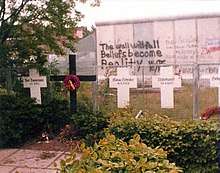Wall of Shame

"Wall of Shame" (German: Schandmauer) is a phrase that is most commonly associated with the Berlin Wall.[1] In this sense the phrase was coined by Willy Brandt and it was used by the government of West Berlin, and later popularized in the English-speaking world and elsewhere from the early 1960s. Inspired by its usage in reference to the Berlin Wall the term has later been applied to a wide range of uses.
The term "Wall of Shame" can be applied to many things, including physical barriers (walls, fences, etc.) serving non-honourable or disputed separation purposes (like the Berlin Wall), physical and virtual bulletin boards listing names or images for purposes of shaming, and even lists in print (i.e. walls of text w. names of people, companies, etc., - listed for purpose of shaming, or as record of embarrassment).
The two concepts "Hall of Fame" and "Hall of Shame" are, in sense of application scope, an antonym pair.
A "Wall of Shame" can be a significant part in the building of a "Hall of Shame", though, more often, a "Wall of Shame" is a monument in its own right (i.e. a wall not having been erected as part of any "Hall of Shame" endeavour).
More recently the term has been used in reference to the Mexico–United States barrier[2], the Egypt–Gaza barrier[3] and the Israeli West Bank barrier.[4]
Applied to Japanese culture
The earliest use may have been by Ruth Benedict and other anthropologists discussing the honor shame culture of Japan.
This phrase, a translation of a Japanese phrase, has been used by anthropologists including Ruth Benedict in her influential 1948 book, The Chrysanthemum and the Sword, to discuss the shame-honor culture of Japan.[5]
Applied to the Berlin Wall

The term was used by the government of West Berlin to refer to the Berlin Wall, which surrounded West Berlin and separated it from East Berlin and the GDR. In 1961 the government of East Germany named the erected wall as the "Anti-Fascist Protection Wall", a part of the inner German border; many Berliners, however, called it "Schandmauer" ("Wall of Shame"). The term was coined by governing mayor Willy Brandt.[6] Outside Germany it first appeared as "Wall of Shame" in a cover story published by Time Magazine in 1962,[7] and President of the United States John F. Kennedy used the term in his Annual Message to the US Congress on the State of the Union, January 14, 1963.[8]
The Berlin Wall was referred to as the "Wall of Shame" in many more recent notable works, such as:
- Mário Soares, former Prime minister and later President of Portugal (1986-1996), in his academic article "The Democratic Invention"[9]
- The "Our Europe" Speech by Jacques Chirac, President of France, to the Bundestag, 27 June 2000[10]
- 2002 Speech by Romano Prodi, Prime Minister of Italy and former President of the European Commission[11]
Other uses
- In 1998, UNIFEM organized a photo exhibit at the United Nations that contrasted a "wall of shame", focusing on women's plight and suffering, with a "wall of hope" showcasing initiatives to end violence against women.[12]
- An academic paper by M. Lachance (York University) talks about the Quebec "wall of shame".[13]
- Peru's Wall of Shame, a ten-foot high wall separating San Juan de Miraflores and Surco outside Lima.[14][15]
- A moniker used to describe the 2016 separation wall around the Ain al-Hilweh camp in Lebanon, intended to separate the local Palestinian-Lebanese population from the surrounding society[16]
References
- ↑ Udo Greinacher, The Wall of Shame: The Berlin Wall, University of California, Berkeley, 1991
- ↑ http://www.aljazeera.com/programmes/general/2007/11/2008525184011488706.html
- ↑ http://articles.latimes.com/2009/dec/21/world/la-fg-egypt-wall21-2009dec21
- ↑ https://www.un.org/press/en/2003/ga10216.doc.htm
- ↑ Modell, Judith (1999). "THE WALL OF SHAME: RUTH BENEDICT'S ACCOMPLISHMENT IN "THE CHRYSANTHEMUM AND THE SWORD"". 24 (2): 193–215. JSTOR 29790601.
- ↑ Julia Sonnevend (2016): Stories Without Borders: The Berlin Wall and the Making of a Global Iconic Event, p. 47, Oxford University Press, ISBN 9780190604325
- ↑ "CNN Cold War - First Draft: Title". Archived from the original on May 2, 2006.
- ↑ Gerhard Peters and John T. Woolley (January 14, 1963). "John F. Kennedy: "Annual Message to the Congress on the State of the Union."". The American Presidency Project. The American Presidency Project. Retrieved 26 September 2013.
- ↑ Journal of Democracy 10.2 (1999) 105-112
- ↑ "Archived copy" (PDF). Archived from the original (PDF) on 2006-09-25. Retrieved 2006-05-06.
- ↑ "Archived copy" (PDF). Archived from the original (PDF) on 2011-07-19. Retrieved 2006-05-06.
- ↑ Spindel, Cheywa; Levy, Elisa; Connor, Melissa (2000). Judd, Karen, ed. With an End in Sight: Strategies from the UNIFEM Trust Fund to Eliminate Violence Against Women (PDF). The United Nations Development Fund for Women. ISBN 0-9679502-9-5. Retrieved 2010-12-07.
- ↑ M. Lachance (York University): "Geographies of protests: spatialities of social movements activities" (2003)
- ↑ Mervin, John (October 9, 2015). "In Peru water is a high price for Lima's poor". BBC. Retrieved October 21, 2016.
At the very top of the hill, is the final insult that Lima adds to the injurious effects of poverty: a wall, ten feet high, garlanded with razor wire. ... They call it the Wall of Shame.
- ↑ Robinson, Julian (December 22, 2015). "Peru's ten-foot high Wall Of Shame topped with razor wire which divides the rich and poor to stop the less well-off stealing from the wealthy". The Daily Mail. Retrieved October 21, 2016.
- ↑ Arab, The New. "Lebanon begins building 'security wall' around Palestinian refugee camp".
